Michael J. Behe's Blog, page 569
November 15, 2018
Study: Neanderthals did not live more violently than other ancient peoples

Neanderthal/Photaro
From a study of over 200 skulls:
Males suffered the bulk of harmful head knocks, whether they were Neandertals or ancient humans, the scientists report online November 14 in Nature.
“Our results suggest that Neandertal lifestyles were not more dangerous than those of early modern Europeans,” Harvati says. Bruce Bower, “Skull damage suggests Neandertals led no more violent lives than humans” at Science News
That’s a curious headline, Skull damage suggests Neandertals led no more violent lives than humans“,” as if Neanderthals were not humans.
It makes sense that the Neanderthal was not more violent than others. Life back then was probably as violent as it could be among humans who — after all — can foresee and avoid chances of getting killed.
Follow UD News at Twitter!
See also: Neanderthals walked normally, upright, say researchers
No one evolved faster than the Neanderthal Look how smart he got in the last few decades (if you go by a discussion of Neanderthals and language)
Two Neanderthal children from 250 kya showed lead exposure, and much else So much more information is coming to light about Neanderthals and other vanished peoples that it’s getting harder than ever to find the missing link. We find plenty of stories instead.
and
Neanderthal Man: The long-lost relative turns up again, this time with documents
Copyright © 2018 Uncommon Descent . This Feed is for personal non-commercial use only. If you are not reading this material in your news aggregator, the site you are looking at is guilty of copyright infringement UNLESS EXPLICIT PERMISSION OTHERWISE HAS BEEN GIVEN. Please contact legal@uncommondescent.com so we can take legal action immediately.
Plugin by Taragana
What algorithms can’t figure out and why

Jonathan Bartlett
Jonathan Bartlett, Research and Education Director of the Blyth Institute, asks, Who needs wisdom? if We’ve got algorithms! ?
In our increasingly digital society, the algorithm seems set to replace wisdom in human reasoning. While we are seeing some pushback against the movement to “algorithmicize” everything, few lay out explicitly the limitations as well as the benefits of the algorithms increasingly used to make decisions.
Recently, the Wall Street Journal ran an article on the current contentions within Netflix between “the Algorithm” (Netflix’s data-driven decision-making model) and “Hollywood” (the face-to-face deal-making that dominates the movie and TV businesses). For instance, the Algorithm was in favor of canceling the GLOW series, due to the lackluster performance of the comedy featuring women’s wrestling, while the Hollywood side believed that Netflix needed the show to bolster its standing in the cinematic community.
As you can see from the description of the dispute, the Algorithm and Hollywood approached the question from completely different points of view. The Algorithm offered a narrow view (ratings) while Hollywood offered a “big picture” perspective. More.
Who was right?
Maybe, in the run-up to a ridiculously messy and expensive meltdown, someone will come up with as popular song along the lines of:
Algo-RHYTHms, Yes we DO!
We’ve got THEM and so do YOU!
We can hum it during the mop-up operation.
Follow UD News at Twitter!
See also: Also by Jonathan Bartlett: Did AI show that we are a peaceful species triggered by religion? No, but this episode shows how science media sometimes help mislead the public
Self-driving vehicles are just around the corner On the other side of a vast chasm…
and
Guess what?: You already own a self-driving car. Tech hype hits the stratosphere
Copyright © 2018 Uncommon Descent . This Feed is for personal non-commercial use only. If you are not reading this material in your news aggregator, the site you are looking at is guilty of copyright infringement UNLESS EXPLICIT PERMISSION OTHERWISE HAS BEEN GIVEN. Please contact legal@uncommondescent.com so we can take legal action immediately.
Plugin by Taragana
When Peer-Reviewers Are Really Political Fanboys
Climate contrarian uncovers scientific error, upends major ocean warming study
“The findings of the … paper were peer reviewed and published in the world’s premier scientific journal and were given wide coverage in the English-speaking media,” Lewis wrote. “Despite this, a quick review of the first page of the paper was sufficient to raise doubts as to the accuracy of its results.”
Really? A casual review of the first page by one person with a modicum of skepticism found issues that a whole team of experts missed in their peer review process? Yes. Why? Easy. When it comes to climate change, the politics come first. Facts take the hindmost. And sometimes that winds up biting them in their, ahem, nether regions, shall we say.
Copyright © 2018 Uncommon Descent . This Feed is for personal non-commercial use only. If you are not reading this material in your news aggregator, the site you are looking at is guilty of copyright infringement UNLESS EXPLICIT PERMISSION OTHERWISE HAS BEEN GIVEN. Please contact legal@uncommondescent.com so we can take legal action immediately.
Plugin by Taragana
John Sanford gives lecture at NIH on mutations and human health

Geneticist John Sanford is also the author of Genetic Entropy: and one of the editors of Biological Information: New Perspectives: Proceedings of a Symposium Held May 31 Through June 3, 2011 at Cornell University
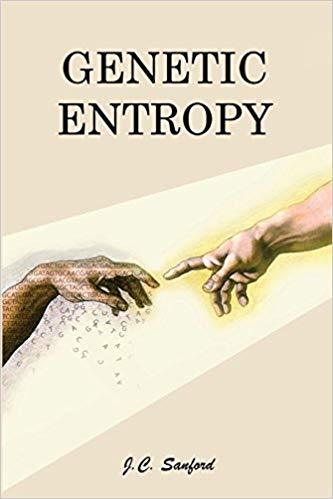
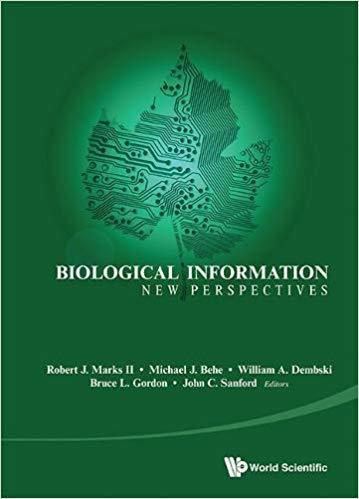
Note: In a distinctly unsavoury move, devout Darwinians managed to get Biological Information dropped by Springer. It is all the more valuable to read for that reason.
Nick Matzke famously got the publishing company Springer to suppress the publication of the papers of a conference held at Cornell. See here. He did this without having seen, much less read, any of the papers. Obviously, his motivation could not have been the content of the papers. He was motivated by the mere fact that several of the conference participants were well-known ID proponents. More.
See also: John Sanford: Darwin a figurehead, not a scientist
John Sanford: Accepting Darwinism’s collapse is a matter of scientific integrity
A peek at Mike Behe’s new book Darwin Devolves We’re told that the basic thesis is, The First Rule of Adaptive Evolution: Break or blunt any functional gene whose loss would increase the number of offspring.
and
Three new studies “shake up” study of human migrants to North America We used to think the picture was pretty simple but not any more
Copyright © 2018 Uncommon Descent . This Feed is for personal non-commercial use only. If you are not reading this material in your news aggregator, the site you are looking at is guilty of copyright infringement UNLESS EXPLICIT PERMISSION OTHERWISE HAS BEEN GIVEN. Please contact legal@uncommondescent.com so we can take legal action immediately.
Plugin by Taragana
November 14, 2018
A peek at Mike Behe’s new book Darwin Devolves
While Stephen Colbert has called Michael J. Behe the “Father of Intelligent Design,” Behe’s arguments have been called, “close to heretical” by the New York Times Book Review, and Richard Dawkins has publicly taken him to task for his “maverick” views. Wherever he goes, Behe makes waves, but has remained singularly focused on doing rigorous scientific analysis that points to controversial but incredible results that other scientists won’t touch.
Twenty years after publishing his seminal work, Darwin’s Black Box, Behe shows that new scientific discoveries point to a stunning fact: Darwin’s mechanism works by a process of devolution, not evolution. On the surface, evolution can help make something look and act different, but it doesn’t have the ability to build or create anything at the genetic level.
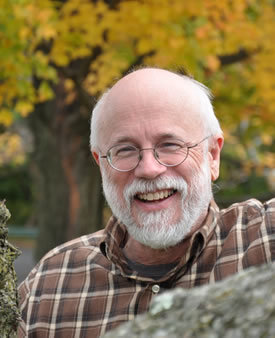
Critically analyzing the latest research, Behe gives a sweeping tour of how modern theories of evolution fall short and how the devolving nature of Darwin’s mechanism limits them even further. If we are to get a satisfactory answer to how the most complex, stunning life-forms arose, it’s time to acknowledge the conclusion that only an intelligent mind could have designed life.
We’re told that the basic thesis is, The First Rule of Adaptive Evolution: Break or blunt any functional gene whose loss would increase the number of offspring.
You can preorder (February 26, 2019) and get a free extra chapter.
Lehigh University’s Mike Behe is, of course, also the author of Darwin’s Black Box (1996) and The Edge of Evolution: The Search for the Limits of Darwinism (2007)
Note: The book develops a paper Behe published in the Quarterly Review of Biology (2010),
Adaptive evolution can cause a species to gain, lose, or modify a function; therefore, it is of basic interest to determine whether any of these modes dominates the evolutionary process under particular circumstances. Because mutation occurs at the molecular level, it is necessary to examine the molecular changes produced by the underlying mutation in order to assess whether a given adaptation is best considered as a gain, loss, or modification of function. Although that was once impossible, the advance of molecular biology in the past half century has made it feasible. In this paper, I review molecular changes underlying some adaptations, with a particular emphasis on evolutionary experiments with microbes conducted over the past four decades. I show that by far the most common adaptive changes seen in those examples are due to the loss or modification of a pre-existing molecular function, and I discuss the possible reasons for the prominence of such mutations. – Michael J. Behe, “Experimental evolution, loss-of-function mutations, and “the first rule of adaptive evolution”,” The Quarterly Review of Biology 85, no. 4 (December 2010): 419-445. (paywall)
Copyright © 2018 Uncommon Descent . This Feed is for personal non-commercial use only. If you are not reading this material in your news aggregator, the site you are looking at is guilty of copyright infringement UNLESS EXPLICIT PERMISSION OTHERWISE HAS BEEN GIVEN. Please contact legal@uncommondescent.com so we can take legal action immediately.
Plugin by Taragana
Astonishing! A pop science article on fine-tuning that isn’t just plain stupid

Big Bang/NASA
Get a load of this:
More recently, scientists have pointed out that if one tweaks many of the dimensionless physical constants — numbers like pi that are independent of units and simply exist as fundamental ideas — none of the cosmos we see would exist. One of these numbers is omega, the density parameter, which pits gravity’s pull against the expanding push of dark energy. If gravity were stronger, the universe would have long since ceased expanding, and would have collapsed back down in a reverse Big Bang, often called the “Big Crunch.” If dark energy were stronger, then the universe would race away from itself so that no matter would stick together and stars, planets, and people could never form.
If the cosmos were truly a random and senseless arrangement of particles, it seems eerie or suspicious to many that these two forces balance so delicately. Korey Hanes, “Are the Laws of the Universe Fine-Tuned for Life?” at Discover
Of course, Haynes raises the idea of the multiverse (science’s assisted suicide) but then acknowledges, “we’re drastically short on data.” It sounds as if Haynes thinks data actually matters. Others treat the multiverse as a sort of charm against the importance of data. Once it’s invoked, the weight of the evidence becomes irrelevant.
The commonsensical approach employed here raises an interesting question: If the evidence for fine-tuning grows and no evidence whatever emerges for a multiverse, is there some point at which the weight of the evidence counts? Then what?
Follow UD News at Twitter!
See also: Michael Denton on why the Sun is remarkably fit for life
Fine-tuning: Is Earth’s magnetic core special too, compared to Mars’s?
The early universe was flat to a “suspicious” one part in a million Hence cosmic inflation theory, promoted with some pretty wild theorizing
and
What becomes of science when the evidence does not matter? v
Copyright © 2018 Uncommon Descent . This Feed is for personal non-commercial use only. If you are not reading this material in your news aggregator, the site you are looking at is guilty of copyright infringement UNLESS EXPLICIT PERMISSION OTHERWISE HAS BEEN GIVEN. Please contact legal@uncommondescent.com so we can take legal action immediately.
Plugin by Taragana
If quantum mechanics were a researcher, she’d be fired
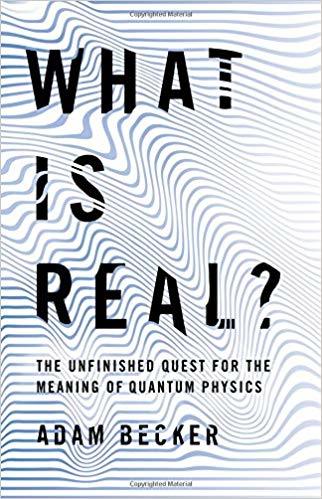 And have to leave academic science. Factually correct answers do not matter now if they are not politically correct. In a review of Adam Becker’s What Is Real? The Unfinished Quest for the Meaning of Quantum Physics (Basic Books, 2018), mathematician and physicist Sheldon Lee Glasgow tells us
And have to leave academic science. Factually correct answers do not matter now if they are not politically correct. In a review of Adam Becker’s What Is Real? The Unfinished Quest for the Meaning of Quantum Physics (Basic Books, 2018), mathematician and physicist Sheldon Lee Glasgow tells us
No one can doubt that quantum mechanics is strange. Who could believe that particles can briefly violate energy conservation so as to pass through otherwise impenetrable barriers?1 Who could believe that a body’s position and velocity could not both be known to an arbitrary degree of precision, yet this is Heisenberg’s uncertainty principle. Who could believe that not more than one electron can occupy the same quantum state, yet this is Pauli’s exclusion principle? How can it be that electrons and protons behave like waves, just as electromagnetic waves behave like particles? All attempts to skirt these quantum-mechanical principles have failed.
As Adam Becker concedes, “[Q]uantum physics certainly works.” Sheldon Lee Glashow, “Not So Real” at Inference Review
We are given the impression that Becker does not like that fact. “Erwin Schrödinger’s cat is one of Becker’s pet preoccupations. The first of her several dozen appearances in his book is on page 2, the last seven on page 257.” What Becker does like is string theory, about which Glasgow says,
Can theories admitting no conceivable experimental test, like string theory or multiverse cosmology, be useful contributions to physics? “Claiming that no data,” Becker argues, “could ever force the rejection of a multiverse theory is merely stating that a multiverse theory is just like any other theory.”8 But the multiverse is not like any other theory. To accept it is to reject any possibility of understanding how neutrinos acquire mass, why weak interactions violate parity, or what determines the mathematical structure of the Standard Model. These mysteries and whatever secrets lie beyond the Standard Model are simply accidents of birth of our particular universe.
Hat tip: Philip Cunningham, who comments,
Quantum mechanics falsifies the naturalistic/materialistic view of reality which holds that space-time, matter-energy is all that there is. In other words, a cause that is completely beyond space-time, matter-energy must be appealed to in order to explain the effect of quantum correlations.
Theists, specifically Christian Theists, have a beyond space-time, matter-energy cause to appeal to. Atheists don’t! In fact, as stated previously, atheistic materialism denies that anything beyond space-time, matter-energy exists.
Follow UD News at Twitter!
See also: Post-modern physics: String theory gets over the need for evidence
and
The multiverse is science’s assisted suicide
Copyright © 2018 Uncommon Descent . This Feed is for personal non-commercial use only. If you are not reading this material in your news aggregator, the site you are looking at is guilty of copyright infringement UNLESS EXPLICIT PERMISSION OTHERWISE HAS BEEN GIVEN. Please contact legal@uncommondescent.com so we can take legal action immediately.
Plugin by Taragana
November 13, 2018
Mystery: Extinct birds as well adapted for flight as surviving modern ones
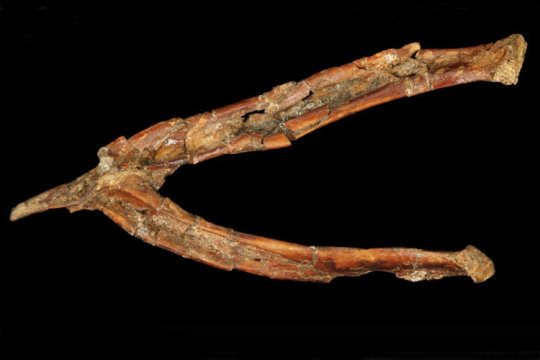
Fossilized wishbone (furcula)David Strauss
But they aren’t the ancestors of the modern ones. They died out, but why? From ScienceDaily:
“We know that birds in the early Cretaceous, about 115 to 130 million years ago, were capable of flight but probably not as well adapted for it as modern birds,” said Atterholt, who is now an assistant professor and human anatomy instructor at the Western University of Health Sciences in Pomona, California. “What this new fossil shows is that enantiornithines, though totally separate from modern birds, evolved some of the same adaptations for highly refined, advanced flight styles.”
…
If enantiornithines in the late Cretaceous were just as advanced as modern birds, however, why did they die out with the dinosaurs while the ancestors of modern birds did not?
“This particular bird is about 75 million years old, about 10 million years before the die-off,” Atterholt said. “One of the really interesting and mysterious things about enantiornithines is that we find them throughout the Cretaceous, for roughly 100 million years of existence, and they were very successful. We find their fossils on every continent, all over the world, and their fossils are very, very common, in a lot of areas more common than the group that led to modern birds. And yet modern birds survived the extinction while enantiornithines go extinct.”
One recently proposed hypothesis argues that the enantiornithines were primarily forest dwellers, so that when forests went up in smoke after the asteroid strike that signaled the end of the Cretaceous — and the end of non-avian dinosaurs — the enantiornithines disappeared as well. Many enantiornithines have strong recurved claws ideal for perching and perhaps climbing, she said.
“I think it is a really interesting hypothesis and the best explanation I have heard so far,” Atterholt said. “But we need to do really rigorous studies of enantiornithines’ ecology, because right now that part of the puzzle is a little hand-wavey.”
We know we are getting somewhere with the science part of it all when “hand-wavey” is seen as a problem.
“What is most exciting, however, are large patches on the forearm bones. These rough patches are quill knobs, and in modern birds they anchor the wing feathers to the skeleton to help strengthen them for active flight. This is the first discovery of quill knobs in any enantiornithine bird, which tells us that it was a very strong flier.” Paper. (open access) – Jessie Atterholt, J. Howard Hutchison, Jingmai K. O’Connor. The most complete enantiornithine from North America and a phylogenetic analysis of the Avisauridae. PeerJ, 2018; 6: e5910 DOI: 10.7717/peerj.5910
More.
Follow UD News at Twitter!
See also: Mystery: ENST comments on the fossil African turaco found in North America at 52 mya …
Shaking the bird family tree: African-type bird fossil from 52 mya found in North America. In this case, what the fossil record tells us poses a problem for biogeography (the distribution of life forms worldwide over time). At 52 million years ago, North America was thousands of kilometres from Africa. Did the birds migrate? Could they?
Reptile had bird-like head 100 million years before birds
Copyright © 2018 Uncommon Descent . This Feed is for personal non-commercial use only. If you are not reading this material in your news aggregator, the site you are looking at is guilty of copyright infringement UNLESS EXPLICIT PERMISSION OTHERWISE HAS BEEN GIVEN. Please contact legal@uncommondescent.com so we can take legal action immediately.
Plugin by Taragana
Physicists: New approach to antimatter offers promising results
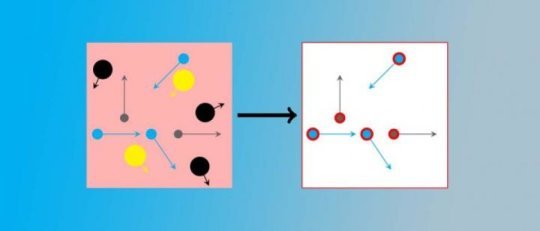
dimensional reduction/David Weir
According to the Standard Model of our universe, beginning with the Big Bang, there is no difference between matter and antimatter (although they annihilate each other on contact). Why then do we see all matter, no antimatter? A group of physicists decided to test a new theory: From ScienceDaily:
About ten picoseconds after the Big Bang — right about the time the Higgs boson was turning on — the universe was a hot plasma of particles.
“The technique of dimensional reduction lets us replace the theory which describes this hot plasma with a simpler quantum theory with a set of rules that all the particles must follow,” explains Dr. David Weir, the corresponding author of the article.
“It turns out that the heavier, slower-moving particles don’t matter very much when these new rules are imposed, so we end up with a much less complicated theory.”
This theory can then be studied with computer simulations, which provide a clear picture of what happened. In particular, they can tell us how violently out of equilibrium the universe was when the Higgs boson turned on. This is important for determining whether there was scope for producing the matter-antimatter asymmetry at this time in the history of the universe using the Two Higgs Doublet Model.
“Our results showed that it is indeed possible to explain the absence of antimatter and remain in agreement with existing observations,” Dr. Weir remarks. Importantly, by making use of dimensional reduction, the new approach was completely independent of any previous work in this model.
If the Higgs boson turned on in such a violent way, it would have left echoes. As the bubbles of the new phase of the universe nucleated, much like clouds, and expanded until the universe was like an overcast sky, the collisions between the bubbles would have produced lots of gravitational waves. Researchers at the University of Helsinki and elsewhere are now gearing up to look for these gravitational waves at missions such as the European LISA project. Paper. (open access) – Jens O. Andersen, Tyler Gorda, Andreas Helset, Lauri Niemi, Tuomas V. I. Tenkanen, Anders Tranberg, Aleksi Vuorinen, David J. Weir. Nonperturbative Analysis of the Electroweak Phase Transition in the Two Higgs Doublet Model. Physical Review Letters, 2018; 121 (19) DOI: 10.1103/PhysRevLett.121.191802 More.
Well, we shall see! This feels so much more like science than hearing someone merely make a claim that there must be another universe out there that is all antimatter.
Follow UD News at Twitter!
See also: Clue about antimatter: Does it depend on how neutrinos behave vs. antineutrinos?
Improved precision in matter-antimatter difference does not resolve mystery
and
Experiments on antimatter are now possible?
Copyright © 2018 Uncommon Descent . This Feed is for personal non-commercial use only. If you are not reading this material in your news aggregator, the site you are looking at is guilty of copyright infringement UNLESS EXPLICIT PERMISSION OTHERWISE HAS BEEN GIVEN. Please contact legal@uncommondescent.com so we can take legal action immediately.
Plugin by Taragana
Plants have developed complex strategies to get ants to help them

Ants shelter in the hollow thorns and thus defend the plant/(c) Field Museum, Corrie Moreau
From ScienceDaily:
A new study in the Proceedings of the National Academy of Sciences breaks down the genetic history of 1,700 species of ants and 10,000 plant genera, and the researchers found that the long history of ant and plant co-evolution started with ants foraging on plants and plants later responding by evolving ant-friendly traits.
…
“There are a number of different structures plants make that are specific for ant use,” explains Nelsen, who led the study with his fellow Field Museum researchers and co-authors Rick Ree and Corrie Moreau. “Some plants have evolved features that persuade ants into defending them from attack from other insects and even mammals. These include hollow thorns that ants will live inside, or extra nectar on leaves or stems for the ants to eat. Some ants will just cheat and take the nectar and run, but some will stick around and attack anything that tries to hurt the plant,” explains Nelsen. Other plants get ants to help them move their seeds around, by bribing them with rich food packets attached to seeds called elaiosomes. “The ant will pick up the seed and carry it away, eat the food packet, and discard the seed — often in a nutrient-rich area where it’ll grow better, and since it’s farther away from its parent, they won’t have to compete for resources.
But how did these complex relationships get started?
The team mapped the history of plant’s ant-friendly traits and of ants’ plant use onto these family trees — a process called ancestral state reconstruction. They were able to determine when plants began relying on ants for defense and seed distribution — and it looks like ants have relied on plants for longer than plants have directly relied on ants, since plants didn’t evolve these specialized structures until long after ants had been relying on them for food and habitat.
So it looks as though the plants came up with the idea. Which makes sense because they are stuck in one place but ants are mobile.
And while there has been a mutually beneficial relationship between ants and plants over the years, from an evolutionary standpoint, groups of ants that eat, forage on or nest in plants don’t seem to be any better off than those that do not. “We don’t see parts of the ant family tree that includes ants relying on plants for food or habitat diversifying or growing any faster than those parts of the tree that lack these interactions,” says Nelsen. “This study matters because it provides a glimpse into how these widespread and complex interactions evolved.” Paper. (paywall) – Matthew P. Nelsen, Richard H. Ree, Corrie S. Moreau. Ant–plant interactions evolved through increasing interdependence. Proceedings of the National Academy of Sciences, 2018; 201719794 DOI: 10.1073/pnas.1719794115 More.
Bet we haven’t heard the last of this story.
Follow UD News at Twitter!
See also: Plants use flashes of fluorescent light to warn leaves against insects
and
Do host plants tell insects whether to stay or leave?
Copyright © 2018 Uncommon Descent . This Feed is for personal non-commercial use only. If you are not reading this material in your news aggregator, the site you are looking at is guilty of copyright infringement UNLESS EXPLICIT PERMISSION OTHERWISE HAS BEEN GIVEN. Please contact legal@uncommondescent.com so we can take legal action immediately.
Plugin by Taragana
Michael J. Behe's Blog
- Michael J. Behe's profile
- 219 followers





